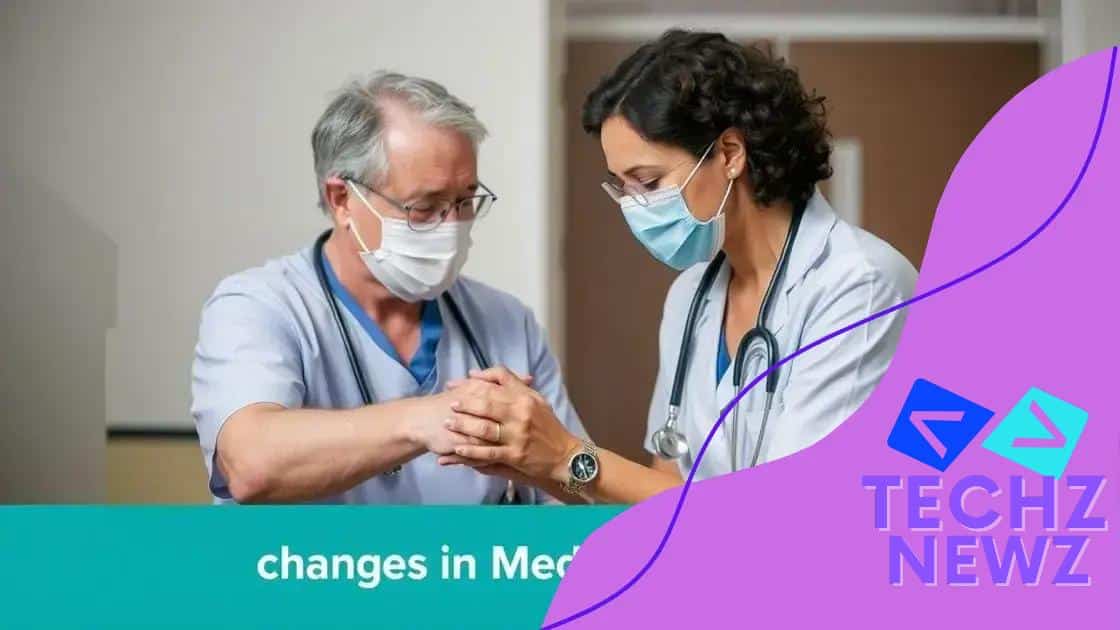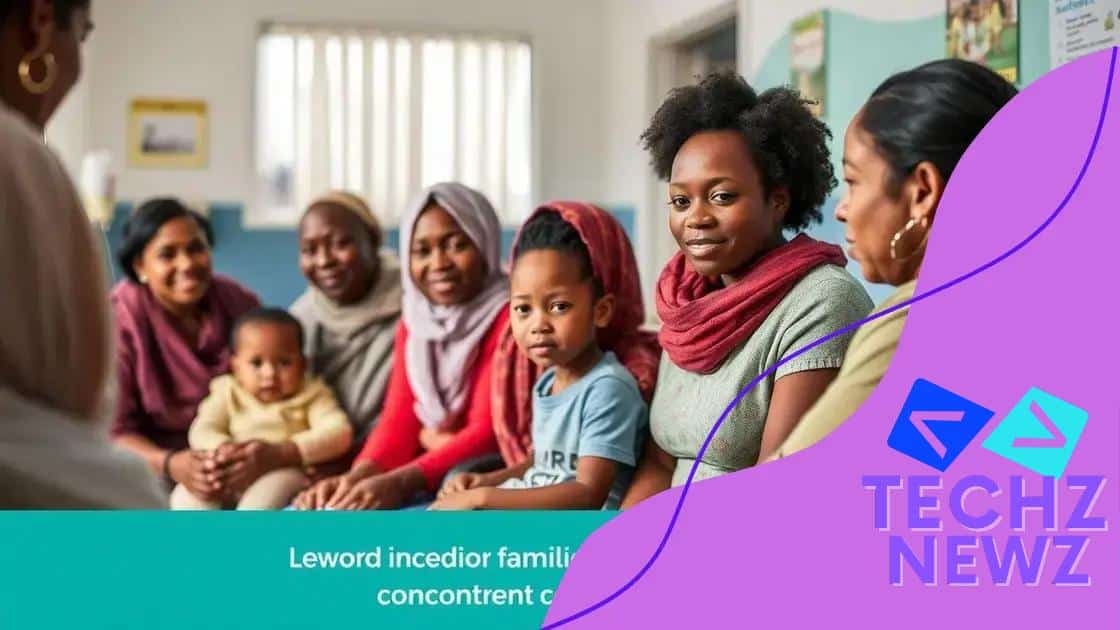The future of Medicaid expansion under new legislation

The future of Medicaid expansion aims to enhance healthcare access for low-income communities by addressing challenges, leveraging technology, and increasing coverage through innovative programs and community engagement.
The future of Medicaid expansion under new legislation is creating buzz across the healthcare landscape. What does this mean for millions relying on these services, and how will it reshape healthcare access? Let’s dive deeper into this evolving topic.
Understanding Medicaid expansion
Understanding Medicaid expansion is crucial as it impacts millions across the United States. This initiative aims to increase access to healthcare for low-income individuals and families, ensuring they receive essential medical services.
What is Medicaid Expansion?
Medicaid expansion is a provision under the Affordable Care Act that allows states to expand their Medicaid programs. By doing so, they can cover more people, particularly low-income adults who previously did not qualify. This shift helps address significant gaps in healthcare access.
Benefits of Medicaid Expansion
With Medicaid expansion, various benefits arise:
- Increased access to healthcare services
- Better health outcomes for individuals
- Reduced emergency room visits
- Enhanced economic stability for families
Moreover, the expansion creates opportunities to invest in preventive care, which can result in long-term health benefits. By providing coverage, additional support systems become available. Health education and preventive services can effectively decrease the prevalence of chronic diseases.
The decision to expand Medicaid is not solely a healthcare issue but also a significant economic one. By reducing uninsured rates, states often experience lower healthcare costs overall. In some cases, they may even receive federal funding to cover the costs of new enrollees. This federal support can bring much-needed revenue to state economies.
Challenges Faced
Despite these advantages, there are challenges as well. Some states are hesitant to expand due to budget concerns or political opposition. Additionally, there is a need for robust systems to ensure that those eligible are aware of their options. Public awareness campaigns and outreach efforts become critical to overcoming these hurdles.
Understanding Medicaid expansion is a step towards grasping the larger healthcare landscape. By exploring the various sides—benefits, economics, and challenges—stakeholders can engage in meaningful discussions to shape the future of healthcare access.
Key changes in new legislation
The key changes in new legislation surrounding Medicaid expansion are reshaping healthcare access for millions. Understanding these changes helps individuals navigate the evolving landscape of health insurance and medical services.
Enhanced Coverage Options
One significant alteration is the enhancement of coverage options for adults under the new rules. This allows states to provide benefits that were previously unavailable. As a result, more individuals can access vital healthcare services.
Increased Federal Funding
The new legislation also includes provisions for increased federal funding. This financial support aims to cover state expenses in expanding Medicaid. With more federal dollars flowing, states can support additional enrollees and improve services.
- Lower out-of-pocket costs for patients
- Increased resources for mental health services
- Access to preventative care
- Support for prescription medications
With the added funding, states can afford to enhance their Medicaid programs. This means better health outcomes can be achieved over time. Furthermore, states gain flexibility in how they manage their programs, fostering innovation in delivering care.
Accountability and Performance Metrics
Another crucial change is the emphasis on accountability and performance metrics. States will need to demonstrate that their Medicaid programs effectively serve the population. This shift ensures that funds are used responsibly and that recipients receive quality care.
Through this accountability, improvements can be made continuously. Stakeholders, including healthcare providers and patients, may witness better service delivery. The focus on performance metrics helps maintain the integrity of the Medicaid system, ensuring it evolves alongside the needs of the community.
In summary, the key changes in new legislation bring numerous enhancements to Medicaid expansion. These updates create a pathway for improved access and quality of healthcare across states, benefiting low-income individuals and families significantly.
Impact on low-income communities

The impact on low-income communities due to Medicaid expansion is both profound and far-reaching. Many individuals and families in these areas face barriers to accessing healthcare, and the expansion aims to remove those barriers.
Access to Essential Services
One of the most significant benefits is increased access to essential services. With expanded coverage, low-income individuals can receive necessary medical care, regular check-ups, and preventative services. This helps improve overall health outcomes in the community.
Reduction of Health Disparities
The legislation also plays a key role in reducing health disparities. Many low-income communities often struggle with higher rates of chronic diseases like diabetes and heart disease. By expanding access to healthcare, these communities can receive the treatment and management needed to improve their quality of life.
- Improved maternal and child health
- Increased screenings for diseases
- Better management of chronic conditions
- Access to mental health services
Furthermore, as more people gain coverage, the overall health of the community begins to improve. This creates a healthier environment for families. In turn, healthier individuals can participate more actively in their communities and local economies, leading to positive economic ripple effects.
Economic Stability
Access to Medicaid also enhances economic stability for low-income families. With less time spent worrying about medical bills or unexpected healthcare costs, families can focus on other aspects of their lives, such as education and employment. This stability contributes to building a stronger community.
Moreover, as healthcare services become more accessible, local businesses in low-income communities can thrive. This is due to fewer missed workdays from health-related issues, which boosts productivity. The expansion of Medicaid effectively bolsters the economy by supporting both health and finance.
Overall, the impact on low-income communities through Medicaid expansion can lead to healthier individuals, stronger families, and more resilient local economies. It is clear that this change fosters better living conditions and long-term benefits for these populations.
Challenges and opportunities
The challenges and opportunities surrounding Medicaid expansion present a complex landscape for states and communities. While the benefits are clear, several hurdles must be addressed to fully implement these changes.
Challenges of Medicaid Expansion
One challenge is the financial burden on state budgets. Expanding Medicaid requires significant funding, and not all states are prepared to absorb this cost. This can create tension between state and federal governments regarding financial responsibilities.
Public Awareness and Education
Another challenge involves public awareness. Many eligible individuals may not know they qualify for expanded benefits. Outreach efforts are vital to ensure the communities understand the new options available to them.
- Creating accessible information materials
- Holding community workshops
- Utilizing social media campaigns
- Partnering with local organizations
Additionally, staffing shortages in healthcare facilities can hinder the delivery of services to those newly eligible. Without adequate numbers of healthcare workers, the system risks becoming overwhelmed.
Opportunities for Improvement
Despite these challenges, there are significant opportunities within Medicaid expansion. One opportunity is the chance to innovate healthcare delivery. States can explore new models such as telehealth and community health programs that can enhance access to care.
These innovations can lead to better health outcomes for underserved populations. By investing in technology and education, healthcare providers can reach individuals who may have previously faced barriers.
Furthermore, Medicaid expansion can stimulate local economies. By providing low-income individuals access to healthcare, more people can participate in the workforce. This can lead to improved productivity and overall economic growth.
The landscape of Medicaid expansion is filled with both challenges and opportunities. Addressing challenges head-on while capitalizing on opportunities can lead to a healthier future for many communities across the nation.
Future outlook for Medicaid programs
The future outlook for Medicaid programs appears promising, yet it is shaped by various factors including policy decisions, economic conditions, and community needs. As Medicaid expansion continues in several states, the focus is on enhancing services and improving outcomes for beneficiaries.
Expansion Opportunities
Many states are considering further expansion of Medicaid to include more individuals. This could potentially provide additional coverage for low-income adults. Increased enrollment can lead to a greater pool of resources, allowing for better care across various services.
Technology and Innovation
Advancements in technology present new opportunities for Medicaid programs. Telehealth services are gaining traction and can significantly improve access to care. This approach helps individuals who may face challenges traveling to healthcare facilities, thereby enhancing service delivery.
- Improved patient outcomes through remote monitoring
- Increased access to specialists
- Cost-effective care delivery models
- Enhanced patient education and engagement
Moreover, data analytics can help Medicaid programs identify gaps in care and target resources more effectively. States can leverage data to make informed decisions about where to allocate funds and which services to enhance.
Policy Considerations
As policies evolve, the direction of Medicaid will likely shift based on legislative decisions. Policymakers must consider the needs of their communities when shaping future regulations. Listening to feedback from healthcare providers and patients is essential for meaningful improvements.
The involvement of community organizations can also play a critical role. By collaborating with stakeholders, Medicaid can better address the unique needs of diverse populations and ensure that services are accessible to all.
Overall, the future outlook for Medicaid programs hinges on proactive measures taken at the state and federal levels. By embracing innovation and addressing community concerns, Medicaid can continue to provide vital services to millions of Americans.
FAQ – Frequently Asked Questions about Medicaid Expansion
What is Medicaid expansion?
Medicaid expansion refers to the process of expanding eligibility for Medicaid to cover more low-income individuals under the Affordable Care Act.
How does Medicaid expansion benefit low-income communities?
It increases access to essential healthcare services, leading to better health outcomes and reduced health disparities.
What challenges does Medicaid expansion face?
Challenges include funding concerns, public awareness, and staffing shortages in healthcare facilities.
What are the future opportunities for Medicaid programs?
Future opportunities include leveraging technology, improving community engagement, and expanding coverage options to reach more individuals.





